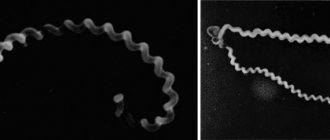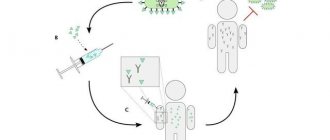Cholera - symptoms and treatment
Cholera is an acute infectious diarrheal disease that poses a particular danger to people. It is caused by the bacteria Vibrio cholerae. Penetrating through the mouth, bacteria affect the intestinal mucosa, disrupting the functioning of the digestive tract. In the absence of adequate treatment, the disease can quickly lead to dehydration, seizures and death [8].
Etiology
Taxonomy of the causative agent of cholera:
- domain - bacteria;
- type - proteobacteria;
- class - gamma bacteria;
- order - Vibrionales;
- family - Vibrionaceae;
- genus - Vibrio (vibrios);
- species - Vibrio cholerae (Vibrio cholerae).
There are many varieties of Vibrio cholerae, but only two serogroups - O1 and O139 - are capable of causing cholera outbreaks. Each of them has its own biotypes:
- Vibrio cholera O1 classica - classic biotype;
- Vibrio cholera O1 El Tor - predominates at present;
- Vibrio cholera O139 Bengal - known since 1992, has caused a major cholera epidemic in Bangladesh, India and other neighboring countries.
The causative agents of cholera are short, curved gram-negative bacteria. In their shape they resemble commas. Their size reaches 0.4-0.6 microns in width and 1.5-3 microns in length.
The bacteria are mobile and do not form spores or capsules. When sowing material, their bluish colonies resemble a school of fish. They are facultative anaerobes, as they are able to obtain energy both in conditions of oxygen and without it. They grow well in alkaline nutrient media.
Vibrios cholerae have a species-specific antigen A and a type-specific antigen O. They contain the genetic information of bacteria and cause an immune response in the body.
The pathogenicity factors of Vibrio cholerae include:
- flagella - make bacteria motile;
- mucinase enzyme - thins the intestinal mucous barrier, facilitating access to the surface of its epithelium;
- neuraminidase enzyme - promotes the production of toxins.
The causative agent of cholera produces two types of toxins :
- endotoxin lipopolysaccharide - does not play a significant role in the development of cholera disease, but can potentially provoke an immune response;
- Cholerogen exotoxin - has a toxic effect only on the intestinal mucosa, causing a massive release of electrolytes and fluid from its cells, leading to diarrhea and dehydration.
Bacteria are very sensitive to acids and alcohol. In feces with sufficient humidity and lack of sunlight they live up to 150 days, in cesspools - over 100 days, in soil - up to 60 days, on fruits and butter - up to 30 days. They survive quite well in low temperatures and freezing conditions. When boiled they die instantly, at a temperature of 56 °C - in 30 minutes. Most antibiotics (mainly tetracyclines and fluoroquinolones) contribute to their destruction [1][2][5][6].
Epidemiology
The source of infection is only humans (patient and carrier). It is most contagious in the first week of illness.
The main foci of cholera are in Africa, Southeast Asia and Haiti, but small outbreaks and isolated cases of the disease are reported throughout the world. The average annual number of cases of the disease is about 5 million people, deaths are about 130 thousand [11].
The transmission mechanism is fecal-oral (water, food and household contact). The main mode of transmission is water. The second most important route is the food route: through meat, seafood, milk, vegetables and fruits that have not undergone adequate heat treatment.
A person, being in the same room with other people, cannot directly infect them. Only the patient’s secretions (feces and vomit) are dangerous if they enter the mouth of a healthy person.
The group at increased risk of developing the disease includes people with blood group O, chronic diseases of the gastrointestinal tract and other organs, the absence or reduced amount of hydrochloric acid in the stomach (achlorhydria or hypochlorhydria).
Cholera spreads much more easily than other acute intestinal infections: it sooner leads to massive release of the cholera pathogen in feces and vomit, which do not have an unpleasant odor or color.
Once in bodies of water (including coastal waters), cholera vibrios can persist for a long time and even multiply. This is facilitated by warm, stagnant, slightly brackish water. Also, reproduction and concentration of the pathogen is possible in zooplankton. In general, cholera is a problem in regions where there is no adequate disinfection and purification of drinking water and hygiene rules are not observed.
Susceptibility to the disease is high. Seasonality is usually summer-autumn. In cities, the incidence is higher than in rural areas. Men get sick more often.
The immunity is strong, but it does not protect the body from infection with other types of Vibrio cholerae. Mortality in the modern world is 1-3% [1][3][5][8].
Symptoms of the disease
Symptoms of cholera are varied and include the following:
- elevated temperature (37-38), which may, on the contrary, decrease with the development of the disease (to 34-35 degrees);
- chills4
- profuse and watery diarrhea. The color of the stool varies: it can be yellow-green or brown;
- vomit. Often it occurs without urge, suddenly;
- rumbling in the stomach, flatulence, mild pain;
- feeling that the stomach is full of a lot of fluid;
- feeling of dryness. Lips become dry, you are constantly thirsty, and you experience serious weakness. In some cases, lips may turn blue;
- decreased blood pressure, which is associated with dehydration;
- headaches - and the pain itself is localized in the frontal part.
It is important to understand that the problem is not limited to these symptoms of cholera. If the patient is not provided with timely assistance, he risks complications - and with them the situation is much worse.
Are you experiencing symptoms of cholera?
Only a doctor can accurately diagnose the disease. Don't delay your consultation - call
Complications
Without proper treatment, cholera can quickly become fatal. In the most severe cases, loss of large amounts of fluid and electrolytes can cause death within hours. In other cases, people who do not receive the necessary care may die from dehydration and dehydration shock 1-2 days after the first symptoms of cholera² appear.
Although severe dehydration is considered the most dangerous complication of cholera, other problems can occur with this pathology:
- Low blood sugar (hypoglycemia). Low levels of sugar (glucose) in the blood - the main source of energy for the body - are characteristic of severe forms of cholera. Hypoglycemia can be accompanied by convulsions, loss of consciousness and lead to death. Children are most susceptible to low glucose levels due to cholera.
- Low potassium levels (hypokalemia). Patients with cholera, due to diarrhea, lose a large amount of electrolytes, including potassium, as a result of which the functioning of the heart and nervous system is disrupted, which poses a threat to the patient’s life.
- Kidney failure. When the kidneys lose their filtering ability, excess fluid, some electrolytes and metabolic products accumulate in the body, which is also life-threatening.
- Secondary infection. Against the background of cholera, the body becomes more susceptible to other bacteria. This can lead to complications such as pneumonia, abscesses, and sepsis.
Diagnosis of the disease
When diagnosing cholera, an important point is to find out the places where a person could have contracted this disease - in order to carry out certain sanitary and epidemiological measures and prevent an outbreak of the epidemic.
Next, the doctor interviews the patient to clarify the characteristics of diarrhea and various pains. Additionally, tests are carried out - examination of feces for the presence of a pathogen, as well as examination of blood for the presence of certain antibodies.
Diagnosis of cholera, taking into account a combination of methods, gives an accurate result and allows you to begin effective treatment.
When to see a doctor?
The risk of a cholera outbreak in industrialized countries is low. Even in regions where it exists, the likelihood of infection is minimal if food safety recommendations are followed. However, cases of cholera occur throughout the world.
Therefore, if a person develops severe diarrhea after visiting an area with recent cases of cholera, it is time to seek immediate medical attention².
Features of cholera in children
At the age of under 3 years, the dehydration characteristic of cholera is much more severe. Because of this, children quickly develop signs of dysfunction of the nervous system in the form of severe general lethargy, convulsions and even loss of consciousness. Moreover, unlike adults, the body temperature of children with cholera often rises to 37.5-38.0°C.
Surveillance
Cholera surveillance should be part of an integrated disease surveillance system that includes local feedback and global information sharing.
Cases of cholera are identified based on clinical suspicion of the disease in patients with severe acute watery diarrhea. The suspicion is further confirmed by identifying V. cholerae bacteria in stool samples from the respective patients. Case detection can be facilitated by the use of rapid diagnostic tests (RDTs), where a positive test result on one or more samples triggers case notification of cholera. Samples are sent to the laboratory for culture or PCR testing to confirm the diagnosis. Local capacity to detect (diagnosis) and monitor (collect, compile and analyze data) cases of the disease is central to ensuring an effective surveillance system and cholera control planning.
Countries affected by cholera are urged to strengthen disease surveillance and improve national preparedness to quickly detect and respond to outbreaks. Under the International Health Regulations (IHR), reporting of all cholera cases is no longer mandatory. However, public health events associated with cholera should always be assessed against the criteria provided in the Regulations (IHR Annex 2 – Decision Tree) to determine whether formal notification is necessary.
Further information on Annex 2 of the IHR can be found here
Questions and answers
Is Cholera Deadly?
Timely treatment of cholera allows the patient to fully recover. But deaths do occur; as a rule, they are caused by the patients themselves.
Do you only get cholera in poor countries?
No, this disease can occur in any country - the difference is in the number, intensity and regularity of outbreaks. Hygiene should always be maintained.
How dangerous is cholera for children?
In children, cholera usually occurs in a more complex form and involves severe dehydration. They are especially in need of quick help.
Have there been major cholera outbreaks?
Yes, there are as many as seven cholera pandemics in history. The first falls on the years 1816-1824, and the seventh – on the years 1961-1975.
The current danger of cholera: how high is it?
At the moment, the danger is much lower than half a century ago - outbreaks of the disease are rare and relatively small. However, precautions related to your own health will still not hurt.
Clinical guidelines for cholera suggest that those least likely to be at risk are people who practice good hygiene and avoid visiting potentially dangerous places. In the event of a disease, the winner is the one who, at the first symptoms, turns to infectious disease specialists or calls an ambulance. Also, the described symptoms may be related to other infectious diseases - their timely detection can also save the patient’s life.
Preventive measures
Prevention of cholera is as follows:
- take the cholera vaccine recommended by WHO. In different countries, immunization of the population is carried out centrally and is strictly controlled. However, it contributes to the development of general immunity - for each individual person, the effect of the vaccine weakens over time, so other preventive measures are required;
- avoid those countries and regions where outbreaks of the disease are regularly observed;
- eat only food that has been heat-treated or washed well with soapy water;
- use exclusively clean water from those sources that are intended for this purpose;
- wash your hands regularly;
- store food in suitable conditions - away from places where insects land on it.
It is also recommended to monitor the situation in the region, and if cholera outbreaks are detected nearby, it is necessary to strengthen control over hygiene, food and water quality.
Classification
Several classifications of cholera are used in clinical practice. This is due to differences in the symptoms of the disease and treatment approaches in different cases. Also, some forms of the disease may have a course uncharacteristic of classical cholera.
Depending on the developing symptoms, cholera is divided into the following forms:
- Typical or gastrointestinal. The classic form of cholera, accompanied by gastrointestinal disorders.
- Atypical. It includes several subspecies that differ significantly from the typical variant of the disease. Atypical forms of cholera include:
- Lightning fast. It is characterized by extremely rapid development with pronounced vomiting and diarrhea, due to which severe dehydration quickly develops, and dehydration shock occurs within 3-4 hours.
- Dry. It is characterized by a sharp deterioration in the general condition of a person. Even before the onset of diarrhea, a coma may develop.
- Erased. It has relatively mild symptoms: the frequency of bowel movements per day ranges from 1 to 3 times, and the stool is not modified. The general condition is often satisfactory; the diagnosis is established only at the stage of laboratory tests.
- Asymptomatic. A variant of infection that occurs without any clinical manifestations. It is detected only after laboratory diagnostics.
It is customary to distinguish vibration carriers separately. This is a condition in which an infected person releases Vibrio cholerae into the environment, but does not show signs of illness. He may have the following options:
- Convalescent. It is observed in people who are recovering from cholera.
- Transitional. Characteristic for people who are in the center of a cholera outbreak. They become infected, but their body successfully fights off the infection. As a rule, it lasts no more than 3 months.
- Chronic. A condition in which cholera vibrios remain active in the body and a person continues to release them into the environment for more than 3 months.
Depending on the patient’s condition, the severity of damage to the gastrointestinal tract and the degree of dehydration, the following degrees of severity of cholera are distinguished:
- Easy. It is characterized by the accumulation of Vibrio cholerae toxins in the body. Defecation is repeated 3-5 times a day, general health remains satisfactory. There are minor feelings of weakness, thirst, dry mouth. The illness lasts 1-2 days.
- Average. Intoxication of the body is moderate. In this case, diarrhea is accompanied by vomiting, which is not accompanied by nausea. There is intense thirst and other signs of dehydration. Stool up to 15 times a day, copious. Single muscle cramps may be observed. The duration of the disease is 4–5 days.
- Heavy. Pronounced consequences of severe intoxication of the body. There are pronounced signs of dehydration due to copious (up to 1–1.5 liters per bowel movement) stool with a frequency of up to 35 times a day. Repeated vomiting in a fountain. Painful muscle cramps in the limbs and abdomen. The skin of the hands and feet becomes wrinkled (“washerwoman’s hand”). The face takes on a characteristic appearance: sharpened features, sunken eyes, cyanosis of the lips, ears, earlobes, nose.
“Washerwoman’s hands” is a characteristic symptom of cholera. Photo: PHIL CDC









